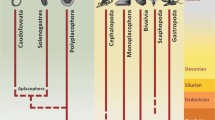Abstract
The morphology and some functions of the gut of Fritillaria pellucida and Fritillaria formica (Fritillaridae) were investigated by light and electron microscopy, and also by means of histochemical and immunohistochemical techniques. Fritillarids, very important for their abundance and ecological impact in marine ecosystems, have a very simplified gut: a straight oesophagus connects the pharynx to the digestive nucleus, composed of globular stomach and rectum, connected dorsally through a very short proximal intestine. The latter is characterised by a few (two to four) extremely specialised cells, completely filled with mitochondria associated tightly with membrane infoldings showing strong ATP-ase activity, and probably involved in the osmoregulation of internal body fluids. The gut is formed of an extremely low number of cells, which, although poorly diversified, are very large in the stomach and rectum. Food transfer along the gut depends on and is regulated by well-developed cardiac and pyloric valves, and signs of general digestive and absorptive activity are recognisable all along the brush border of the main tracts. The macroscopic organisation and cytological characters of the gut in fritillarids are completely different from those of the oikopleurids. In particular, fritillarids lack specialised cells for endocytosis and intracellular digestion, like those described in the genus Oikopleura. The general simplification and specialisation observed in Fritillaria gut may account for their elevated growth rate and abundant diffusion in all oceans.






Similar content being viewed by others
References
Alldredge AL (1981) The impact of appendicularian grazing on natural food concentrations in situ. Limnol Oceanogr 26:247–257
Båmstedt U, Fyhn HJ, Martinussen M, Mjaavatten O, Grahl-Nielsen O (2001) Seasonal distribution, diversity and biochemical composition of appendicularians in Norwegian fjords. In: Response of marine ecosystems to global change: ecological impact of appendicularians (abstracts). A NATO Advanced Research Workshop. Observatoire oceanographique—LOV, Villefranche-sur-Mer, p 2
Berridge MJ, Oschman JL (1972) Transporting epithelia. Academic Press, New York
Bone Q, Fenaux R, Mackie GO (1977) On the external surface in Appendicularia. Ann Inst Oceanogr 53:237–244
Bone Q, Gorsky G, Pulsford AL (1979) On the structure and behaviour of Fritillaria (Tunicata: Larvacea). J Mar Biol Assoc UK 59:399–411
Burighel P, Cloney RA (1997) Urochordata: Ascidiacea. In: Harrison FW, Ruppert EE (eds) Microscopic anatomy of invertebrates, book 15. Hemichordata, Chaetognatha and the invertebrate chordates. Wiley Liss, New York, pp 221–347
Burighel P, Dallai R, Martinucci GB (1985) Scalariform junction in the gut of tunicates. Biol Cell 54:171–176
Burighel P, Brena C, Martinucci GB, Cima F (2001) Gut ultrastructure of the appendicularian Oikopleura dioica (Tunicata). Invertebr Biol 120:278–293
Cima F, Brena C, Burighel P (2002) Multifarious activities in the gut epithelium in an appendicularian (Oikopleura dioica: Tunicata). Mar Biol 141:479–490
Copeland DE (1967) A study of salt secreting cells in the brine shrimp (Artemia salina). Protoplasma 63:363–384
Deibel D, Lee SH (1992) Retention efficiency of sub-micrometer particles by the pharyngeal filter of the pelagic tunicate Oikopleura vanhoeffeni. Mar Ecol Prog Ser 81:25–30
Deibel D, Powell CVL (1987) Ultrastructure of the pharyngeal filter of the appendicularian Oikopleura vanhoeffeni: implications for particle size selection and fluid mechanics. Mar Ecol Prog Ser 35:243–250
Deibel D, Turner JT (1985) Zooplankton feeding ecology: contents of fecal pellets of the appendicularian Oikopleura vanhoeffeni. Mar Ecol Prog Ser 27:67–78
Fenaux R (1961) Rôle du pylore chez Fritillaria pellucida Busch (Appendiculaire). CR Acad Sci Ser III Sci Vie 252:2936–2938
Fenaux R (1963) Ecologie et biologie des Appendiculaires méditerranéens (Villefranche-sur-Mer). Vie Milieu [Suppl 16]:1–142
Fenaux R (1998a) The classification of Appendicularia. In: Bone Q (ed) The biology of pelagic tunicates. Oxford University Press, Oxford, pp 295–306
Fenaux R (1998b) Anatomy and functional morphology of the Appendicularia. In: Bone Q (ed) The biology of pelagic tunicates. Oxford University Press, Oxford, pp 25–34
Flood PR, Deibel D (1998) The appendicularian house. In: Bone Q (ed) The biology of pelagic tunicates. Oxford University Press, Oxford, pp 105–124
Flood PR, Deibel D, Morris C (1992) Filtration of colloidal melanin from sea water by planktonic tunicates. Nature 355:630–632
Fol H (1872) Études sur les Appendiculaires du détroit de Messine. Mém Soc Phys Hist Nat Genève 21:445–499
Gomori G (1948) Histochemical demonstration of sites of choline esterase activity. Proc Soc Exp Biol Med 68:354–358
Gorsky G, Fenaux R (1998) The role of Appendicularia in marine food webs. In: Bone Q (ed) The biology of pelagic tunicates. Oxford University Press, Oxford, pp 161–169
Kimura S, Ohshima C, Hirose E, Nishikawa J, Itoh T (2001) Cellulose in the house of the appendicularian Oikopleura rufescens. Protoplasma 216:71–74
Lopez-Urrutia A, Acuña JL (1999) Gut throughput dynamics in the appendicularian Oikopleura dioica. Mar Ecol Prog Ser 191:195–205
Martini E (1909) Studien über die Konstanz histologischer Elemente. I. Fritillaria pellucida. Z Wiss Zool 94:81–170
Salensky W (1904) Etudes anatomiques sur les Appendiculaires. III. Fritillaria pellucida Busch. Mem Acad Sci St-Pétersbourg 15:55–90
Acknowledgements
The authors wish to thank Dr. G. Gorsky of the Station Zoologique of Villefranche-sur-Mer for facilities in providing specimens. This work was supported by grants from the EU EURAPP project (contract MAS3-CT98-0161) to P. Burighel. The English text was revised by G. Walton.
Author information
Authors and Affiliations
Corresponding author
Additional information
Communicated by R. Cattaneo-Vietti, Genova
Rights and permissions
About this article
Cite this article
Brena, C., Cima, F. & Burighel, P. The highly specialised gut of Fritillariidae (Appendicularia: Tunicata). Marine Biology 143, 57–71 (2003). https://doi.org/10.1007/s00227-003-1029-4
Received:
Accepted:
Published:
Issue Date:
DOI: https://doi.org/10.1007/s00227-003-1029-4




